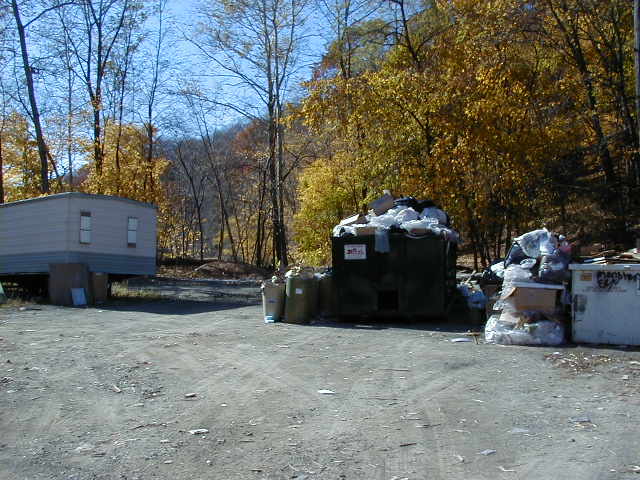
 |
Tips for Businesses:
Keeping Your Stream Healthy
|

|
KNOW WHAT’S HARMFUL TO STREAMS
AND DISPOSE OF WASTES PROPERLY
Operate your business responsibly to eliminate discharges into storm
drains.
Never store waste materials in the street or near the stream.
 Never pour oil or grease down a storm drain
or sanitary sewer.
Never pour oil or grease down a storm drain
or sanitary sewer.
Food service businesses produce pollutants such as oil, grease,
detergents, and food scraps. Grease and oil discharged into storm
drains can enter the stream and decrease the oxygen content of the
water, coat fish gills, and smother bottom-dwelling organisms. Food
scraps can cause excessive nutrient loading in the stream, which uses
up oxygen needed by fish and other organisms.
 Be a zero-discharger.
Be a zero-discharger.
When you reuse and recycle fluids and other products, they never become
wastes. Purchase reusable or recyclable materials whenever you can. If
your business routinely uses chemicals or cleaning compounds, consider
"closed loop" processes that recycle these materials.
 Cover and maintain dumpsters.
Cover and maintain dumpsters.
Open or leaking dumpsters are common causes of water pollution. Close
dumpster lids, place dumpsters under roofs, or cover them with plastic
sheeting at the end of each work day and during rainy weather. Inspect
dumpsters regularly for leaks, and repair or replace any dumpster that
is not water-tight. Return dumpsters to trash haulers for cleaning. Do
not hose them down or clean them on site.
 Clean up leaks, drips, and other spills
without water whenever possible.
Clean up leaks, drips, and other spills
without water whenever possible.
Use rags for small spills, a damp mop for general cleanup, and
absorbent materials (such as cat litter) for larger spills. Clean up
spills immediately. Avoid hosing or wet-mopping outdoor work areas.
Dispose of clean-up materials properly. Do not dump them outside or in
the stream. When cleaning inside, collect mop water and discharge into
a sink or toilet.
 Label storm drains so employees do not
dispose of waste there.
Label storm drains so employees do not
dispose of waste there.
Contact your local Environmental Management Council to find out where
to obtain storm drain stencils.
 Use stream-friendly washing methods for
vehicles and equipment.
Use stream-friendly washing methods for
vehicles and equipment.
Do not wash cars, trucks or other equipment in a paved parking lot or
street where soap and water can flow into the stream or a storm drain.
Install a "wash pad" to capture, pre-treat, and discharge the wash
water to the sanitary sewer or consider using a commercial car wash.
The community storm drain network (gutters, streets, and storm drains)
are designed to carry water to your local water body.
Overflowing
Dumpsters (photo by
DCEMC, 2000)

 Keep pollutants off exposed surfaces.
Keep pollutants off exposed surfaces.
Place trash cans around your business to minimize litter. Dispose of
waste appropriately in covered dumpsters or recycling receptacles.
Trash discarded in the parking lot will eventually wash into the
stormdrain and into the local water body.
 Control parking lot and site drainage.
Control parking lot and site drainage.
Strategic grading of parking lots and other outdoor spaces can prevent
runoff from contacting potentially contaminated areas and reaching
streams and sensitive areas. When building or grading parking areas,
consider installation of oil-water separator equipment in catch basins.
Clean parking lots regularly using street sweepers and dry clean-up
methods, avoiding washing the lot with water.
 Check rain gutters and other pipes to see
where they drain. Make sure they do not carry water directly into the
stream.
Check rain gutters and other pipes to see
where they drain. Make sure they do not carry water directly into the
stream.
Runoff from roof surfaces contributes to the decline of stream health.
Pipes projecting directly into a stream bank or flexible pipes allowed
to drape down a bank cause erosion. Consider using cisterns, on-site
filtration or gray-water systems to capture roof run-off. Contact your
local Environmental Management Council or Soil and Water Conservation
District for additional information.
 Train employees and keep customers
informed.
Train employees and keep customers
informed.
If employees misunderstand how to handle waste, costly pollution
incidents can occur. Make sure that all employees
understand and implement appropriate practices. Educate your customers
as well, and prevent them from disposing of wastes improperly on your
site.
 Carefully remove trash, litter, and other
dumped debris from the stream.
Carefully remove trash, litter, and other
dumped debris from the stream.
Unfortunately, some people think of streams as garbage dumps. You don’t
have to look far to find old shopping carts, used appliances,
mattresses, car parts, bottles, cans, plastic, styrofoam and paper
litter. This debris can become a hazard during floods. It can be a
potential threat to our groundwater quality and provide breeding places
for rodents and mosquitoes. Styrofoam packing material is especially
harmful to wildlife because it can be mistaken for food.
Remove old tires, garbage, and litter from your property. Never store
these materials within the flood zone. They may be carried away during
storm events. If you need help cleaning up the stream, contact some of
the organizations listed on the back page for ideas and assistance.
EMC materials developed by Dave Burns, Watershed Coordinator, Dutchess County Environmental
Management Council.
Tips Menu
|
Watershed Home




 Never pour oil or grease down a storm drain
or sanitary sewer.
Never pour oil or grease down a storm drain
or sanitary sewer.  Be a zero-discharger.
Be a zero-discharger.  Cover and maintain dumpsters.
Cover and maintain dumpsters.  Clean up leaks, drips, and other spills
without water whenever possible.
Clean up leaks, drips, and other spills
without water whenever possible.  Label storm drains so employees do not
dispose of waste there.
Label storm drains so employees do not
dispose of waste there.  Use stream-friendly washing methods for
vehicles and equipment.
Use stream-friendly washing methods for
vehicles and equipment. 
 Keep pollutants off exposed surfaces.
Keep pollutants off exposed surfaces.  Control parking lot and site drainage.
Control parking lot and site drainage.  Check rain gutters and other pipes to see
where they drain. Make sure they do not carry water directly into the
stream.
Check rain gutters and other pipes to see
where they drain. Make sure they do not carry water directly into the
stream.  Train employees and keep customers
informed.
Train employees and keep customers
informed.  Carefully remove trash, litter, and other
dumped debris from the stream.
Carefully remove trash, litter, and other
dumped debris from the stream.